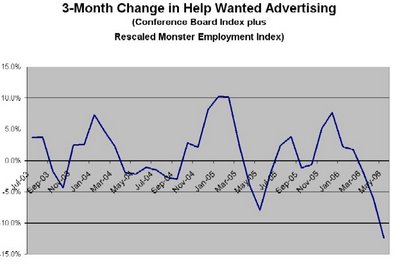US Job Market Jumps Off a Cliff
I wouldn’t read too much into any one indicator, but this one does have me a bit worried. Between February and May, help wanted advertising followed a steady downward trend, declining by over 12% in all, according to the Conference Board. (I have combined the Conference Board’s index with the Monster Employment Index to account for online job advertising. The raw Conference Board index actually declined by more than 15%.) Historically, declines of this magnitude have always been indicative of recessions (for example, March 2001 and November 1990).

There are reasons to think it might be different this time. For one thing, the data could be revised. And measuring the 3-month rate of change is only one of many ways to cut the data. The Monster Index did improve in June. (The Conference Board has not yet reported for June.) Hiring activity may be less important than in the past, as layoff rates are down, and the working-age population is growing more slowly. And employment as reported by households still seems to be rising rapidly. Nonetheless, after the third month of inadequate job growth as reported by firms (in today’s employment release), the decline in help wanted advertising does seem to be part of an unpleasant pattern.

There are reasons to think it might be different this time. For one thing, the data could be revised. And measuring the 3-month rate of change is only one of many ways to cut the data. The Monster Index did improve in June. (The Conference Board has not yet reported for June.) Hiring activity may be less important than in the past, as layoff rates are down, and the working-age population is growing more slowly. And employment as reported by households still seems to be rising rapidly. Nonetheless, after the third month of inadequate job growth as reported by firms (in today’s employment release), the decline in help wanted advertising does seem to be part of an unpleasant pattern.
Labels: data, economics, jobs, labor, macroeconomics, US economic outlook


5 Comments:
Dear Knzn
I know the Conference Board tracks online ads as well as print, but I wonder if the massive move to online job listings is having an effect on the this statistic.
I wonder if your index correlates with the changes in non-farm payroll employment by BLS. It seems to me that the trend in your graph and the one in the BLS' share some similarities.
I also wonder if there is a short time lag between your Help Wanted Index (increases first) and the Non-farm payroll employment (increases, say, one month later).
Your Help Wanted Index would gain more weight as one of the recession predictors if the above relationship holds.
BTY, very interesting post.
It's the Monster Employment Index. Monster.com? Online jobs site? Safe to say that the index includes online job listings, I think.
Chickens are finally coming home to roost. External inflation driving prices up, Fed raising rates as fast as they can, no consumer savings to take the shock, employment already extremely low and diving lower, CRUNNNNNNNNCH. That noise you hear is the U.S. economy hitting a wall.
Maybe people just all realized how useless those help-wanted ads are, all at once?
The jobs report and help wanted index certainly aren't the only indicators pointing to recession.
Take a look at Krainer's report on housing for the San Francisco Fed.
Post a Comment
<< Home